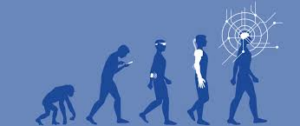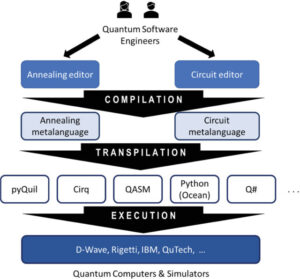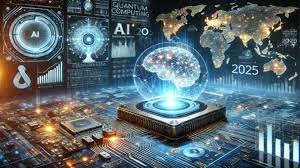The Coming Quantum Revolution
Mankind has always developed along with its instruments—most notably from the acquisition of fire to the invention of the wheel, from industrial machinery to the internet. We are on the threshold of making yet another leap of transformation. The photo reflects this journey—from primal hominids to the smartphone population, and now towards a time when human and smart machines blend. But just as the smartphone transformed communication and access to information, quantum computing has the potential to redefine the very language of computing itself. It’s not an improvement—it’s a reimagining of what computers are. As we enter this new world, we’re not only adjusting to technology; we’re becoming a part of it.
Bits vs. Qubits: Two Very Different Worlds
Classical Computing: The World We Know
From gigantic machines such as ENIAC to the tiny phone in your pocket, all traditional computers use several main concepts:
-
Binary Logic: Everything is a 0 or a 1—such as millions of miniature switches being either on or off.
- Step-by-Step Instructions: Computers have straightforward instructions, one following another, similar to a recipe.
-
Clear Outcomes: Read from a memory location, and you obtain an unambiguous result.
This model has worked for us. We’ve constructed everything from rockets to video-sharing apps with it. But quantum mechanics provides a quite different—and much more bizarre—approach.
Programming in the Quantum World
Classical Programming: The Predictable Path
Classical programming is based on logic and predictability. Here’s a simple Python example:
Languages such as Python, Java, C++, and JavaScript all adhere to this deterministic reasoning. They provide us with control, clarity, and structure.
Quantum Programming: Embracing the Unknown
Quantum programming is an entirely different way of thinking—more surfing waves of probability than following a script. Here‘s a glimpse in Python with Qiskit:
This innocuous-looking code produces a superposition—a state where the qubit is both 0 and 1 until measured. Every time you execute it, you’ll have a random outcome: occasionally 0, occasionally 1. That’s not a glitch—it’s quantum indeterminacy at work.
The Quantum Developer’s Toolbox
Quantum programming languages are changing rapidly. Here are some of the best ones:
-
Qiskit – IBM’s open-source library with Python integration
-
Q# – Microsoft’s language with Visual Studio support
-
Cirq – Google’s Python-based toolkit for near-term devices
-
Silq – A high-level language that aims to minimize programmer mistakes
These platforms usually come with visual tools to assist you in comprehending how quantum states evolve during computation.
The Hardware Challenge: Theory to Reality
Quantum computing sounds amazing in theory—but hardware is difficult to build. Here‘s why:
-
Decoherence: Qubits lose quantumness when exposed to the outside environment.
-
Error Rates: Quantum computations still have error rates of around 0.1–1%.
-
Cooling Requirements: Most quantum systems operate close to absolute zero (–273.15°C).
All these make practical quantum computing very difficult, but scientists are constantly making headways every day.
Getting Started with Quantum Computing
Ready to venture out into this new world? These websites can assist you in getting started:
-
IBM Quantum Experience – Explore real quantum hardware in your browser
-
Amazon Braket – Quantum computing offered as a cloud service
-
Microsoft QDK – Tutorials and tools to teach you quantum programming
-
QWorld & Qiskit Summer School – Free classes to take along with you
The Quantum Horizon: What’s Coming Next?
By 2030: Near-Term Breakthroughs
-
Quantum Advantage: Real-world tasks where quantum beats classical
-
Error Correction: More stable quantum computations
-
Industry Adoption: Especially in finance, pharmaceuticals, and logistics
Beyond 2030: Long-Term Potential
-
Quantum Machine Learning: Pattern recognition beyond classical AI
-
Quantum Internet: Secure, entanglement-based communication
-
Quantum Simulation: Modeling molecules and materials beyond today’s capabilities
Conclusion: Programming’s Next Leap
It takes more than learning a new language to move from classical to quantum programming—it’s learning to think differently about computing itself.
The programmers who can connect these two worlds—who grasp the logic of classical systems and the mathematics of quantum probability—will shape the future of technology.
As physicist Richard Feynman famously put it:
“Nature isn’t classical, dammit. If you want to make a simulation of nature, you’d better make it quantum mechanical.”
The revolution in programming quantum is already underway.
Are you ready to take the leap?



